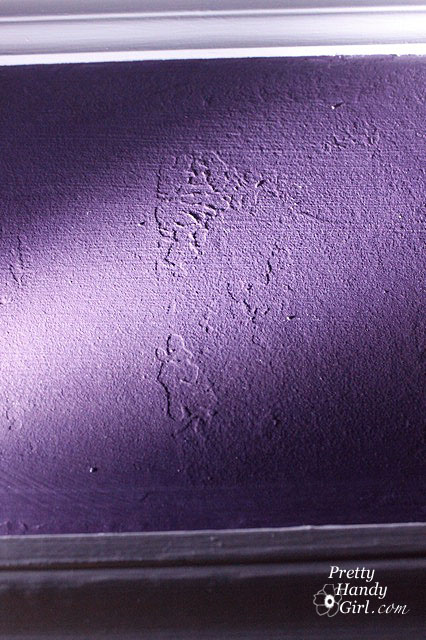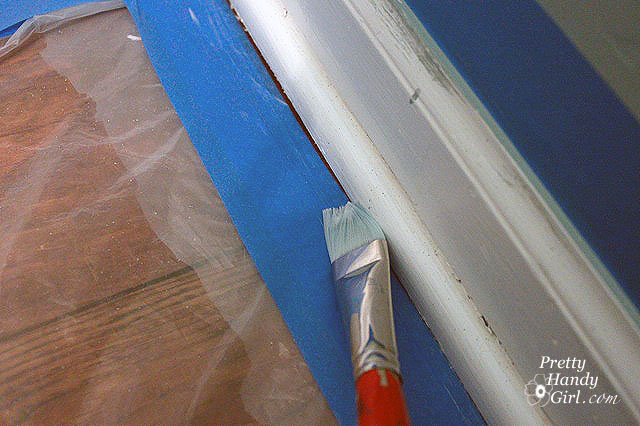Painting Like a Pro – Step 1. 80% is the Prep Work
After years of painting rooms, I have perfected the process and can tell you that 80% of a professional paint job is in the preparation. Today’s post will be about properly prepping your room before painting. Then I’ll post next week on how to paint your room like a pro.
Start by removing everything from your room that isn’t bolted down to the floor (notice how I said “floor”.) You will be removing anything that is attached to the wall. That includes towel bars, TP holders, pictures, outlet covers and switch plate covers. I will allow you to leave a light fixture if it is a sconce style. But, otherwise, get it out of there, ALL of it! We are doing it we’ve started painting like a pro.
But, how do you remove those toilet paper holders and towel rods if you can’t see the screw?

Here is the top secret, hidden location of those wall mounted accessories. Get down on your hands and knees and look up. Underneath there is a teeny tiny hole.
And inside that hole is usually either a hex screw or a flat head screw. You will need a little hex wrenches or flat head screwdriver to undo the screw. A flashlight may also be helpful. Turn the screw until you can pull the fixture off the mounting bracket.
Once your room has been emptied, bring in the tarps, towels, newspapers or plastic. Cover anything that is left in the room. Painter’s drop cloths work the best, but they can be expensive. I usually use plastic drop cloths, then put a folded towel in the entrance of the room to wipe my feet on should I step in any drips.
Even the neatest painter will drip paint! And if you are a klutz like me, you may even step in the paint tray. (Not a good thing.)
Are you paying attention? This next task is the most important to truly achieve a professional paint job (in my opinion.) Have you assessed the condition of your walls. Do you have any holes or dimples in it?
You will need to patch any and all holes (unless it is a picture hanger and you are going to use the same hanger after painting), HERE is the tutorial for patching all types of holes.
Okay, no holes now, but do you really know how smooth your walls are? Well, turn off the lights to find out!
And don’t forget to bring a flashlight. Aim your flashlight parallel to the walls and let the light beam skim the surface. Suddenly you will see all the imperfections. The bigger ones need to have some spackle or joint compound added to smooth them out. Any hills or bumps need to be sanded down.
Soon your walls will look like this!
After your spackle or joint compound is dry, be sure to sand it smooth.
Then use a damp sponge and a pail of fresh water to remove any and all dust. You will probably need to rinse out your sponge frequently. (Especially if you patched as much as I did.)
Time to tape! Start by taping any light fixtures or permanent fixtures in the room. If you are re-painting your entire room (ceilings, trim and doors) I’d wait to tape the molding and door or window trim. For our downstair’s bathroom I knew I was going to repaint the trim too, so I left it exposed to be sure I got the wall color all the way down to the trim and even onto it. Tomorrow I’ll show you why I do this.
If you don’t need to paint your trim, you can use a handy dandy tape dispenser like the one below, but honestly, I can tape off the trim just as fast by hand (after years of practice).
Here is another little pro painting secret, if you want to keep the paint from bleeding under the tape, you can seal it with matte medium (available at artist supply stores.)
Simply pour a small amount into a cup and then brush it on the edge of your tape where it meets the surface you are going to paint.
This puts an invisible seal over your tape edge. It won’t work ALL of the time, but it will really cut down on any seepage and therefore any touch ups you have to do later. You’re well on your way to painting like a pro!
Other Steps in this Series:
Step 3. painting your room and finishing touches

















Here is my “paint behind the toilet tip:” 1. Remove the lid to the tank. 2. Cover the entire toilet with a large garbage bag. 3. Adhere a tiny painting sponge to a paint stick. The brand I use will actually FIT on the end, but if yours doesn’t, double stick tape is great. 4. Paint with this tool behind the toilet! WORKS GREAT!
I adjusted this tip from a pro painter’s blog I read.
Great tip! Thanks for sharing.
Great tips, Sarah. Of all the tips on painting I’ve read in the last year, yours is the first I’ve seen using a clear coating on the tape line. I do something similar to prevent paint bleeding under the tape, except I use clear satin paint. It’s in the paint department where you buy your regular house paints. If you want truly sharp, professional lines with minimal touch-up, this is the way to go.
Hi, thank you for sharing this lovely helpful post! I have a question, the walls I want to paint are kinda dirty, like around the light switch, and the trim has built up dust. Do you need to make sure your walls are clean when you prep them for paint, should you be scrubbing away all the dirt first? Thank you hope you can help!
Sarah, definitely! Dirt and oil will repel paint. Try spraying the area with Krud Kutter (my new BCF …best cleaning friend.) And if you think the walls are dirty too, maybe a few drops of dish detergent in a bucket of water and a sponge to clean the rest.
Okay great, thank you!
Help I’m about to rip my hair out My husband removed a light from my kitchen ceiling I now have a big spot where the light use to be I’m having a hard time trying to match the color to the rest of my ceiling I have patched the hole’s now I just need to paint the spot Just to add to my problem my ceiling isn’t white It’s more of a light alabaster color I’m so frustrated
great blog that I’m just finding! And great tips! But what I want to know is HOW on earth do you get behind the toilet????????
Nicole, if you want to paint behind the tank, you have three options.
1. Take the tank off the toilet. You can see how to do that in this post: https://prettyhandygirl.com/2011/05/toilet-repairs-part-3-replacing-the-overflow-tube-and-flapper.html
2. If the tank isn’t too close to the wall you can use a skinny roller, trim pad or brush.
3. Paint as far back as you can, and be okay with the wall you can’t see ;-).